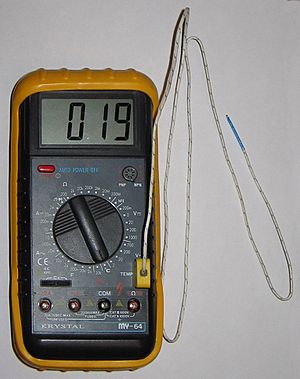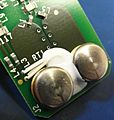Thermocouple facts for kids
A thermocouple (say "THUR-moh-koop-ul"), or TC for short, is a cool device that can turn heat directly into electricity. It can also do the opposite: use electricity to create heat or even cold!
Contents
How Thermocouples Work
Imagine you connect two wires made of different types of metal at one end. If you heat up where these two wires join, a small amount of electricity will start to flow through them.
When things get hot, tiny particles called electrons get more energy and start moving around a lot. In a thermocouple, these electrons will naturally cross the spot where the two different metals meet. Because the metals are different, the electrons lose some of their "stored" energy (called potential energy) and gain "moving" energy (called kinetic energy). It's a bit like a ball rolling down a hill to a lower spot.
The electricity created by one thermocouple is very small, usually just a few millivolts. But if you connect many thermocouples together, you can make a larger amount of electricity. This group of connected thermocouples is called a thermopile.
Thermocouples can also work in reverse! If you connect two different wires at both ends to form a loop, and then send electricity through this loop, one connection point will get hot, and the other will get cold. This is how they can act like a mini-refrigerator! At the hot spot, electrons gain energy as they cross, making the metal warm. At the cold spot, electrons lose energy, making the area cool.
It's a bit tricky to measure the exact electricity a thermocouple makes. This is because any wires you use to connect a voltmeter (a device to measure electricity) might be made of different metals than the thermocouple itself. This creates another tiny thermocouple right where you connect your voltmeter! Even in computer chips, engineers find that almost every electrical connection acts like a tiny thermocouple, whether they want it to or not.
What Thermocouples Are Used For
One common place you might find thermocouples is in gas heaters with a small pilot flame. Many thermocouples are stacked together to form a thermopile. The heat from the pilot flame creates enough electricity to keep the gas valve open, which supplies gas to the flame. If the pilot flame goes out (maybe the gas runs out), the thermopile stops making electricity, and the gas valve automatically closes. This is a great safety feature!
Thermocouples are also used in space! Many space probes get their electricity from a thermopile that uses heat from a special power source called a radioisotope thermoelectric generator.
You can find thermocouples in many other places too. They help monitor temperatures in air conditioning systems, refrigerators, and even inside computer CPUs. Keeping an eye on CPU temperature is important because if it gets too hot, it could be damaged.
Different Kinds of Thermocouples
There are hundreds of different types of thermocouples, but only eight of them are recognized and used all over the world.
Some common types use what are called "base metals":
- Type E (made of chromel and constantan)
- Type J (made of iron and constantan)
- Type N (made of nicrosil and nisil)
- Type T (made of copper and constantan)
- Type K (made of chromel and alumel)
Other types, like B, R, and S, use more expensive metals such as platinum or a mix of platinum and rhodium.
Images for kids
-
A typical low-cost Type K thermocouple with its standard connector. The wires can handle high heat, but the plastic insulation will start to melt around 300°C.
-
This picture shows a thermocouple (the tube on the far right) inside the burner part of a water heater.
See also
 In Spanish: Termopar para niños
In Spanish: Termopar para niños







